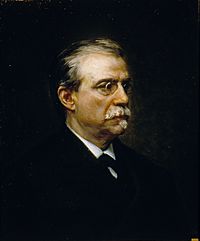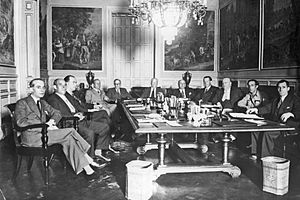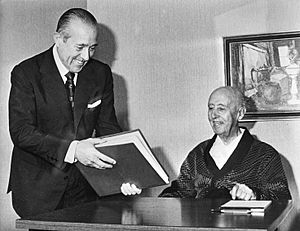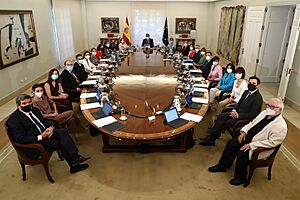Council of Ministers (Spain) facts for kids
| Consejo de Ministros | |

|
|
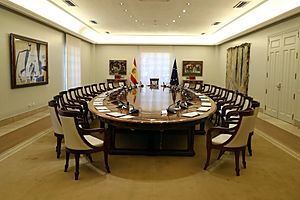 Council Room, Moncloa Palace |
|
| Council of Ministers overview | |
|---|---|
| Formed | November 19, 1823 |
| Jurisdiction | Government of Spain |
The Council of Ministers (Spanish: Consejo de Ministros) is the main group that makes important decisions for the Government of Spain. It includes the Prime Minister, the deputy prime ministers, and all the other ministers. As of 2020, there were 22 ministers. Other officials, like Secretaries of State, are not usually part of this Council. The King can also lead a Council meeting if the Prime Minister invites him.
The Prime Minister suggests who should be a minister, and the King officially appoints them. Ministers do not have to be members of parliament. Each minister usually leads a specific government department. Some ministers might not lead a department; they are called "ministers without portfolio" and handle special government tasks.
The Council is the most important decision-making body of the government. Ministers can also meet in smaller groups called Government Delegated Committees. These committees handle smaller issues that might affect more than one ministry.
The Minister of the Presidency acts as the Secretary of the Council of Ministers. The Council's rules are found in Article 98 of the Spanish Constitution and the Government Act of 1997.
Contents
How the Council of Ministers Started
Early Beginnings (15th-18th Century)
In the past, kings ruled Spain with the help of trusted people. These people, often called ministers, would meet with the king to discuss important matters. Over time, these meetings became more organized. The Spanish monarchy often used "Councils" to help govern. These included the Council of Castile and the Council of the Indies. Their main jobs were to give advice to the King and manage justice.
Under King Charles I, this system grew, especially with the creation of the Council of State in 1526. This Council dealt with the biggest problems of the monarchy. Its secretaries, known as Secretaries of State, held a lot of power.
Later, under kings like Philip III and Philip IV, a "favourite" appeared. This person was like a prime minister. The position of "secretary of the Dispatch" also became important.
With King Philip V, influenced by France, the "Council of Dispatch" was created. It advised the monarch and took over some tasks from the Council of State. Many Secretaries of State and Dispatch appeared during his rule.
The Supreme State Board

The Council of Ministers, as we know it today, was officially created in 1823. However, before that, there was the Supreme State Board. King Charles III created this Board in 1787, following advice from the Count of Floridablanca. It included Secretaries of State and other important people who discussed government issues.
This Board was not exactly a Council of Ministers. It included people who were not ministers, and its discussions were limited by specific rules. The Board did not last long. Critics said the Count of Floridablanca was trying to take too much power through it.
The Royal Decree of 8 July 1787, which created the Board, stated:
I have decided that, in addition to the Council of State, there will be a Supreme Board, like the one I currently use. It will be made up of all the Secretaries of State. When serious matters come up, other Ministers of the Council of State, or Generals, or other useful people, will join.
This Board must meet at least once a week. It will be held at the First Secretary of State's office. There will be no special rules about who sits where, so that my service and the good of the crown are not delayed. (...)—Royal Decree of 8 July 1787, Charles III
The Board was later ended in 1792. Briefly, King Ferdinand VII brought it back in 1815.
The Official Council of Ministers
After a period called the Trienio Liberal, King Fernando VII officially created the Council of Ministers. On 19 November 1823, he ordered his Secretaries of State to meet and form this new body. In these meetings, they would discuss common issues. Each Secretary would report on their area and receive instructions from the King. The First Secretary of State would lead meetings when the King was not there.
The first meeting happened on 22 November. The Ministers of Justice, War, and Treasury and Navy attended.
The King closely controlled this Council. For example, it was suspended for a period in 1825-1826 by Ferdinand VII's direct orders. There were often disagreements between the Council of Ministers and the Council of State. The King later made the Council of State only an advisory body.
The King created the Council to undo changes from the Liberal Triennium. A royal decree from December 1823 set out its goals:
1st. Create good police throughout the Kingdom.
2nd. Break up the old Army and form a new one.
3rd. Have nothing to do with Chambers or any kind of representation.
4th. Remove all supporters of the Constitutional System from government offices.
5th. Work to destroy secret societies.
6th. Not recognize the constitutional loans.—Royal decree of December 1823, Ferdinand VII
At first, the Council had five ministers, later six, plus a secretary. They usually met once or twice a week. Sometimes, other officials would attend to give reports, especially on money or international matters. These were called "assistants."
Meetings were often held at the First Secretary of State's office. They also met wherever the King was, like at the Royal Palaces.
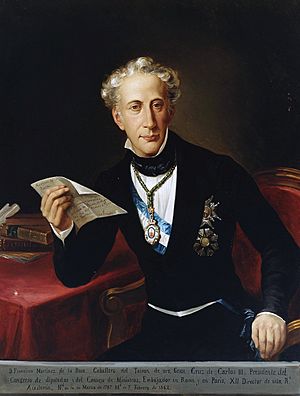
After King Ferdinand VII died, during the time María Christina was regent, Martinez de la Rosa became Secretary of State. He was given the title of President of the Council of Ministers. This made him the first true Prime Minister of Spain. The Royal Statute, a new law, officially recognized the Council of Ministers for the first time.
The Royal Statute said the monarch could freely appoint and remove ministers. However, in practice, the monarch had to choose ministers who had the support of the Cortes Generales (parliament). This was similar to other European systems where the government needed the trust of both the Crown and Parliament.
Early Council meetings under Martinez de la Rosa and Mendizábal were usually not attended by the Queen Regent. They met once or twice a week. During Mendizábal's time, meetings sometimes had very few members due to absences.
Under General Espartero's regency, forming stable governments was hard. Espartero wanted to hold power himself. His ministers resigned because they believed the monarch should "reign but not rule." This led to uprisings against Espartero. Joaquín María López became prime minister and declared Queen Isabella II old enough to rule, which the Cortes supported.
When Narváez became Prime Minister, his Council of Ministers helped create the Constitution of 1845. Political instability was common, with governments lasting only a few months. Narváez's third government (1847-1851) brought stability and important reforms. His Council also managed the Revolutions of 1848 in Spain, ruling with strong control.
In 1851, Juan Bravo Murillo became President of the Council. His government focused on administration and finance. They also improved relations with the Holy See. He tried to reform the constitution, but it was rejected, leading to his resignation. After this, political instability returned until 1874.
The Restoration (1875-1923)
After a period of political changes, the Bourbon monarchy returned with Alfonso XII as King. The Constitution of 1876 was approved. It was flexible, allowing different political ideas to coexist. This led to a two-party system called turnismo. The Liberal and Conservative parties took turns in power. This system aimed for stability, even if it meant influencing election results.
The new Constitution gave the King executive power, which he delegated to his ministers. The role of the President of the Council of Ministers (Prime Minister) became more important. This period saw the establishment of a true civilian government.
However, the turnismo system had problems. It relied on the Ministry of the Interior to manage election results. The system provided stability from 1875 to 1903. But internal party conflicts and new parties, like the Spanish Socialist Workers' Party, caused a crisis.
When Alfonso XIII became King, Spanish politics changed. The young King wanted a central role in decision-making. He told his ministers that he would personally grant honors and titles, even though the Constitution said ministers should approve such decisions. This showed the King's desire for power.
The system became unstable. In the 21 years until Primo de Rivera's coup, there were 33 governments, each lasting about 8 months.
Primo de Rivera's Dictatorship (1923-1930)
On 13 September 1923, Primo de Rivera led a military coup. King Alfonso XIII approved it and appointed him head of government. A Military Directorate was set up, led by Primo de Rivera. It had full executive and legislative powers. The positions of President of the Council of Ministers and the Council itself were removed.
In December 1925, the Military Directory ended. A Civil Directory was formed, and the positions of President of the Council of Ministers and ministers were brought back. The role of Vice President of the Council of Ministers was also restored.
A draft Constitution in 1929 allowed the monarch to attend and lead Council of Ministers meetings. It also gave the King power to appoint ministers without portfolio. This project did not become law. Primo de Rivera resigned and was replaced by General Berenguer Fusté. The local elections of 1931 led to the end of the monarchy and the start of the Second Republic.
The Second Republic (1931-1939)
With the Second Republic and the Constitution of 1931, the Government and the Council of Ministers were seen as the same. Article 86 stated that "the President of the Council of Ministers and the Ministers constitute the Government." The Prime Minister was now clearly the leader of the government. Ministers were responsible for their departments.
The President of the Republic appointed the Prime Minister. The Prime Minister then chose his ministers. However, the President of the Republic could also appoint ministers without portfolio.
The Council of Ministers had the power to propose laws. It could also make regulations and legislate if Congress allowed it. In special cases, the Council could give the President of the Republic power to make temporary laws.
Franco's Dictatorship (1939-1975)
On 18 July 1936, a part of the army rebelled against the government. On 24 July, the National Defense Board was created in Burgos. It took over all state powers. Francisco Franco joined the board in August.
In September 1936, Franco took all state power. A decree on 29 September 1936 stated:
Article one - The Chief of the Government of the Spanish State is appointed to General Francisco Franco Bahamonde, who will take all the powers of the new State.
Article Two.- He is also named Generalissimo of the national forces of land, sea and air, and is given the position of General Head of Operations Armies.
Article third.- This will be announced solemnly to all national groups and foreign Governments.
Fourth Article - Until powers are transferred, the National Defense Board will continue its current duties.
Article Five - Any rules against this Decree are cancelled.—Given in Burgos on 29 September 1936., Miguel Cabanellas
After almost two years of war, a government was formed on the rebel side with Franco as its head. It included a Deputy Prime Minister, a Foreign Minister, and ten other ministers.
Laws from 1938 and 1939 changed the name of the head of government to "President of the Government," a name still used today. This position was linked to the head of the State (Franco). The Council of Ministers existed, but Franco made most decisions. The Council acted more as a technical body, not debating big political questions.
After 1945, the Council of Ministers became more important. This was especially true after Spain's international isolation ended with help from the United States. A new government in 1951 made the Council more political. From 1957, "technocrats" came to power. They focused on economic plans and social laws.
In 1957, the Legal System and State Administration Act made the Council of Ministers the main body of the Administration. It also created Government Delegated Committees to handle smaller issues. The Secretary of the Council was the Minister-Under Secretary of the Presidency.
In 1967, Franco approved a law that separated the head of State from the head of government. The head of government led the Council of Ministers. This law gave the government full power to make regulations. The President of the Government was chosen by the Head of State from a list of three candidates.
The Council of Ministers gained more power as Franco's health declined. In 1973, Franco appointed Luis Carrero Blanco as President of the Government. After Carrero Blanco was assassinated, Carlos Arias Navarro became Prime Minister. The Council of Ministers gained more influence as the dictator's health worsened.
During Franco's rule, the Council of Ministers was used to make decisions seem more legitimate and to protect Franco from blame.
Current Constitution (1978-Present)
With the democratic Constitution of 1978, the idea of the "Government" was separated from the "Council of Ministers." The Constitution says the Government includes the President, Vice Presidents, Ministers, and other members set by law. This means Secretaries of State could be included, but the Government Act of 1997 only included the Prime Minister and ministers. So, the Government and Council of Ministers are still largely the same.
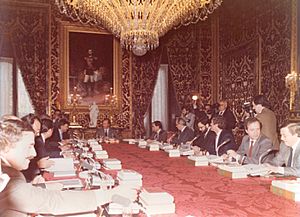
The current system is "presidential," meaning the Prime Minister is the main leader of the government. The Prime Minister is the only one who can ask for a vote of confidence from Parliament. If the Prime Minister leaves office, the whole government also leaves. This shows that the Prime Minister is not just "first among equals."
The parliamentary system means the government must always have the support of parliament. If parliament votes against the government, a new Prime Minister candidate must be named at the same time. If the vote passes, the new candidate automatically becomes the Prime Minister. This "constructive vote of no confidence" has been attempted four times. The first successful one was on 1 June 2018, when Mariano Rajoy was replaced by Pedro Sánchez.
Today, the King does not appoint the head of government directly. The King nominates a candidate, and the Congress of Deputies must approve them. If approved, the King then appoints them. The Prime Minister suggests to the King who should be appointed or removed as ministers. Since 1987, the Prime Minister decides how many ministries the Government will have.
Ministers are not just subordinates. The Constitution says the Prime Minister leads the government, but ministers still have their own responsibilities for their departments.
Council Meetings
The Council of Ministers usually meets every Tuesday morning. These meetings can involve discussions and decisions. The official notes (minutes) only record the time, place, attendees, decisions made, and reports given. The actual discussions among government members are kept secret.
The Prime Minister calls and leads the meetings. If the Prime Minister is absent, a Deputy Prime Minister takes over. The Prime Minister also decides what topics will be discussed. In special cases, the King of Spain can lead a meeting, but then it is only for advice, not for making decisions.
Where the Council Meets
The Council of Ministers usually meets at the Council Building. This building is part of Moncloa Palace, which is where the Prime Minister lives and where the government is based.
However, the Council of Ministers can meet in any city in Spain. For example, they have met in Barcelona (1976 and 2018), Palma de Mallorca (1983), and Seville (1976, 2010, and 2018).
Support for the Council
The Government Act of 1997 describes two bodies that help the Council of Ministers: the General Commission of Secretaries of State and Undersecretaries, and the Government Secretariat.
General Commission
The General Commission of Secretaries of State and Undersecretaries helps the Council of Ministers. It includes all the Secretaries of State and Undersecretaries from different ministries. Its job is to study the topics that will be discussed in the Council of Ministers.
The Deputy Prime Minister or the Minister of the Presidency leads this Commission. The Under Secretary of the Presidency is its secretary. Other senior officials may also attend if their area is being discussed.
Government Secretariat
The Government Secretariat supports the Council of Ministers, the Government Delegated Committees, and the General Commission.
Its responsibilities include helping the Minister-Secretary of the Council of Ministers, organizing meetings, working with the Delegated Committees, keeping records of meetings, ensuring the quality of new laws, and making sure government rules are published correctly in the Official State Gazette.
This body is part of the Ministry of the Presidency.
Current Council
As of March 2023[update]:
| Job | Minister | Time in Office |
|---|---|---|
| Prime Minister | Pedro Sánchez MP | 2018–present |
| First Deputy Prime Minister Minister of Economic Affairs and Digital Transformation |
Nadia Calviño | 2018–present |
| Second Deputy Prime Minister Minister of Labour and Social Economy |
Yolanda Díaz MP | 2020–present |
| Third Deputy Prime Minister Minister for the Ecological Transition and Demographic Challenge |
Teresa Ribera | 2018–present |
| Minister of the Presidency, Relations with the Cortes and Democratic Memory Secretary of the Council of Ministers |
Félix Bolaños | 2021–present |
| Minister of Foreign Affairs, European Union and Cooperation | José Manuel Albares | 2021–present |
| Minister of Justice First Notary of the Kingdom |
Pilar Llop | 2021–present |
| Minister of Defence | Margarita Robles | 2018–present |
| Minister of Finance and Civil Service | María Jesús Montero MP | 2018–present |
| Minister of the Interior | Fernando Grande-Marlaska | 2018–present |
| Minister of Transports, Mobility and Urban Agenda | Raquel Sánchez Jiménez | 2021–present |
| Minister of Education and Vocational Training | Pilar Alegría | 2021–present |
| Minister of Social Rights and 2030 Agenda | Ione Belarra MP | 2021–present |
| Minister of Industry, Trade and Tourism | Héctor Gómez Hernández MP | 2023–present |
| Minister of Agriculture, Fisheries and Food | Luis Planas | 2018–present |
| Minister of Territorial Policy Spokesperson of the Government |
Isabel Rodríguez García | 2021–present |
| Minister of Culture and Sport | Miquel Iceta | 2021–present |
| Minister of Health | José Miñones | 2023–present |
| Minister of Science and Innovation | Diana Morant | 2021–present |
| Minister of Consumer Affairs | Alberto Garzón MP | 2020–present |
| Minister of Equality | Irene Montero MP | 2020–present |
| Minister of Inclusion, Social Security and Migration | José Luis Escrivá | 2020–present |
| Minister of Universities | Joan Subirats | 2021–present |
Cabinet vs. Council
In English-speaking countries, "Cabinet" and "Council of Ministers" might mean the same thing. But in Spain, they are different. The Council of Ministers is the main part of the executive power. The Cabinet is a smaller group that helps the Prime Minister's Office. It includes the Moncloa Chief of Staff and other advisors.
See also
 In Spanish: Consejo de Ministros (España) para niños
In Spanish: Consejo de Ministros (España) para niños
- List of cabinets
- Politics of Spain




